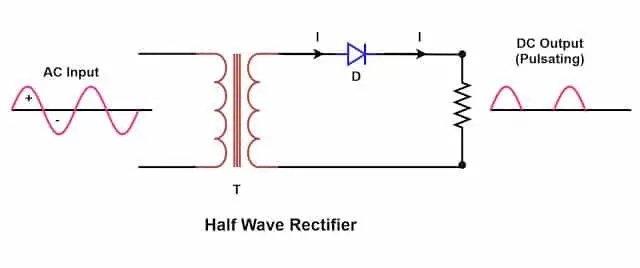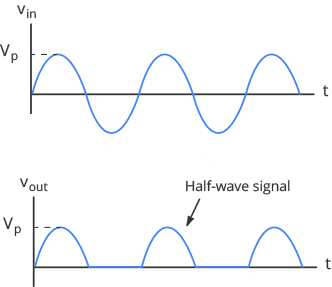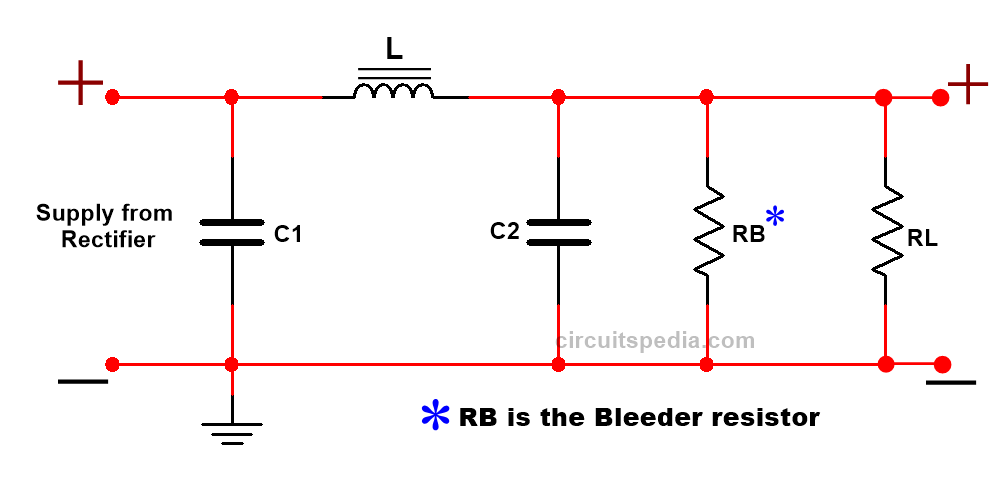Introduction
In the field of electronics and power conversion, rectifiers play a vital role in converting alternating current (AC) to direct current (DC). One of the simplest and most widely used rectifier circuits is the half-wave rectifier. In this blog post, we will discuss the working principles, characteristics, and applications of the half-wave rectifier, providing a comprehensive understanding of this fundamental component.
What is Half-Wave Rectifier
A half-wave rectifier is an electronic circuit that converts an alternating current (AC) input signal into a unidirectional or direct current (DC) output signal by allowing only the positive half-cycles of the input waveform to pass through while blocking the negative half-cycles. It utilizes a diode, a one-way current conducting device, to achieve this rectification process. The output of a half-wave rectifier is a pulsating DC waveform consisting of positive half-cycles, while the negative half-cycles are eliminated.
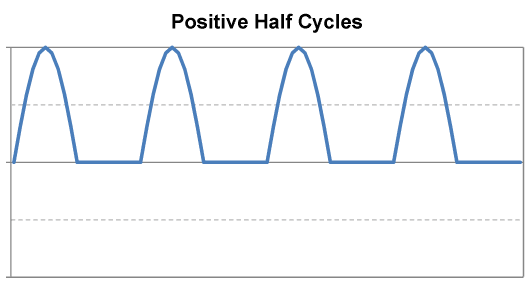
Working Principle
The half-wave rectifier operates on a simple principle. During the positive half-cycle of the AC input voltage, the diode becomes forward-biased, allowing current to flow through the load resistor. This results in a positive half-cycle of the input signal appearing across the load resistor as the output voltage. However, during the negative half-cycle, the diode becomes reverse-biased and blocks the current, resulting in zero output voltage.
-
how many diodes are in a half-wave rectifier
A half-wave rectifier typically uses only one diode in its circuit configuration. The diode is responsible for allowing current flow in one direction (during the positive half-cycles of the input voltage) while blocking current flow in the opposite direction (during the negative half-cycles). Thus, a single diode is sufficient to achieve the rectification process in a half-wave rectifier.
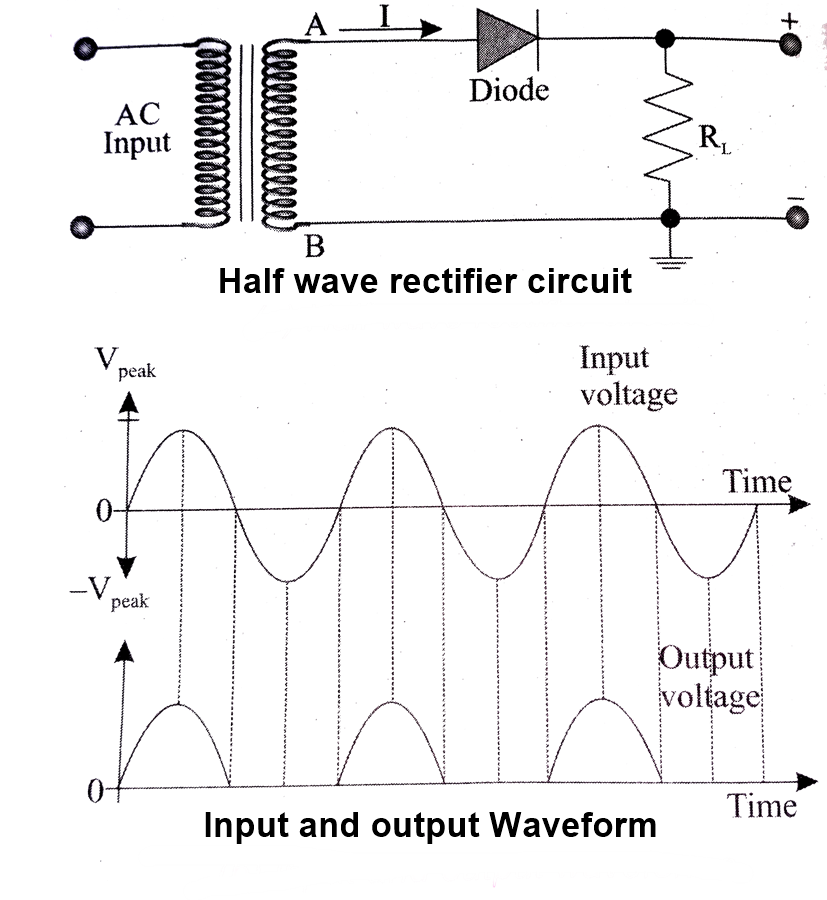
Output Characteristics
The output characteristics of a half-wave rectifier refer to how the output voltage and current behave in relation to the input voltage and load resistance. Let’s explore the key aspects of the output characteristics of a half-wave rectifier.
- Output Voltage:
In a half-wave rectifier, the output voltage is not continuous or smooth. It consists of a series of positive half-cycles, while the negative half-cycles are completely blocked. This results in a pulsating DC waveform with a voltage that rises and falls with each positive half-cycle of the input voltage.
The peak value of the output voltage (Vpeak) can be calculated using the peak value of the input voltage (Vin) and the forward voltage drop across the diode (Vf) using the equation:
Vpeak = Vin – Vf
- Output Current:
The output current of a half-wave rectifier depends on the load resistance (RL) connected to the output. The current flows through the load resistor only during the positive half-cycles of the input voltage when the diode is forward-biased. During the negative half-cycles, when the diode is reverse-biased, no current flows.
The average output current (Iavg) can be calculated using the peak value of the output voltage (Vpeak) and the load resistance (RL) using the equation:
Iavg = Vpeak / RL
It is important to note that the output current contains ripples or fluctuations due to the pulsating nature of the output voltage. These ripples can be minimized by using a filter capacitor in conjunction with the load resistor.
- Ripple Factor:
The ripple factor indicates the amount of fluctuation or ripple present in the output voltage or current of a rectifier. In a half-wave rectifier, the ripple factor is relatively high due to the absence of the negative half-cycles. It can be calculated using the equation:
Ripple Factor = Vrms / Vdc
where Vrms is the root mean square value of the ripple voltage and Vdc is the average DC voltage.
The ripple factor of a half-wave rectifier is typically higher compared to other rectifier configurations, such as full-wave rectifiers. This means that the output is less smooth and may require additional filtering or regulation to reduce the ripple.
In summary, the output characteristics of a half-wave rectifier exhibit a pulsating DC waveform with a voltage that rises and falls during the positive half-cycles of the input voltage. The output current flows through the load resistor only during these positive half-cycles. The ripple factor is relatively high, indicating a noticeable fluctuation in the output voltage or current. Understanding these characteristics helps in designing and analyzing circuits involving half-wave rectifiers.
Advantages and Disadvantages
Advantages of a Half-Wave Rectifier
- Simplicity: The half-wave rectifier is a simple circuit that requires minimal components, making it easy to understand, implement, and troubleshoot.
- Cost-Effectiveness: Due to its simplicity, a half-wave rectifier is cost-effective compared to more complex rectifier configurations.
- Low Component Count: As the circuit requires only a diode and a load resistor, it has a low component count, reducing the cost and complexity of the overall system.
- Low-Power Applications: For low-power applications where efficiency is not a critical factor, a half-wave rectifier can provide a sufficient DC output.
Disadvantages of a Half-Wave Rectifier
- Low Efficiency: The main disadvantage of a half-wave rectifier is its low efficiency. As it blocks the negative half-cycles of the input waveform, a significant portion of the input power is wasted, resulting in low overall efficiency.
- High Ripple Factor: The output of a half-wave rectifier has a relatively high ripple voltage due to the pulsating nature of the output waveform. This can introduce fluctuations and noise into the connected circuitry, which may require additional filtering to minimize the ripple.
- Limited Voltage Output: A half-wave rectifier can only provide a maximum output voltage equal to the peak value of the input voltage minus the forward voltage drop across the diode. This limited voltage range may not be suitable for applications that require higher voltage levels.
- Limited Load Range: The performance of a half-wave rectifier is highly dependent on the load resistance connected to the output. It is suitable for low-load applications, but as the load resistance increases, the output voltage decreases, leading to reduced functionality and applicability.
- Limited Application Scope: Due to its low efficiency and high ripple factor, a half-wave rectifier is typically not suitable for high-power applications or situations that require precise and stable DC voltage. Other rectifier configurations, such as full-wave rectifiers or bridge rectifiers, are more commonly used for such applications.
Applications of Half wave rectifier
The half-wave rectifier, despite its limitations, finds application in various electronic circuits where its simplicity and low-cost make it a suitable choice. Here are some common applications of a half-wave rectifier:
- Power Supplies: In low-power electronic devices, where efficiency is not a critical factor, half-wave rectifiers can be used to convert AC power to DC power. These applications include small battery chargers, simple electronic circuits, and low-power devices where a less efficient rectification method is acceptable.
- Signal Demodulation: Half-wave rectifiers are employed in communication systems for demodulating amplitude modulation (AM) signals. AM radios, for example, use half-wave rectifiers to separate the audio signal from the carrier wave. The rectifier extracts the original audio signal, allowing it to be amplified and reproduced by the speakers.
- Light Dimming: Certain lighting applications utilize half-wave rectifiers to control the brightness of lights. Incandescent bulbs, for instance, can be dimmed using a half-wave rectifier by adjusting the conduction angle of the diode. By varying the time during which the diode conducts, the average power delivered to the bulb is modified, resulting in adjustable light intensity.
- Voltage Level Shifting: In some circuits, a half-wave rectifier can be used as a voltage level shifter. By rectifying an AC signal, the negative part of the waveform is eliminated, resulting in a DC offset. This can be useful in applications where a shifted voltage reference is needed.
- Battery Charging: Half-wave rectifiers can be employed in simple battery charging circuits, particularly for low-power applications. While not the most efficient charging method, it can be useful in situations where a small battery needs to be charged slowly, such as in low-power electronic devices or small portable gadgets.
It is worth noting that while half-wave rectifiers have their applications, they are typically not suitable for high-power applications or situations that require precise and smooth DC voltage. In such cases, more efficient and sophisticated rectifier designs, like full-wave rectifiers or bridge rectifiers, are preferr
Frequently Asked Questions (FAQ)
Q: What is a half-wave rectifier? – A half-wave rectifier is an electronic circuit that converts alternating current (AC) to direct current (DC) by allowing only the positive half-cycles of the input waveform to pass through while blocking the negative half-cycles.
Q: How does a half-wave rectifier work? – A half-wave rectifier works by utilizing a diode, which acts as a one-way valve for electric current. During the positive half-cycles of the input voltage, the diode conducts and allows current flow through the load resistor, creating a positive output voltage. However, during the negative half-cycles, the diode becomes reverse-biased and blocks current flow, resulting in no output voltage during that time.
Q: What are the applications of a half-wave rectifier? – Some common applications of a half-wave rectifier include low-power power supplies, signal demodulation in AM radios, light dimming control, voltage level shifting, and simple battery charging for low-power devices.
Q: What are the advantages of a half-wave rectifier? – The advantages of a half-wave rectifier include its simplicity, low cost, and low component count. It is easy to understand, implement, and troubleshoot, making it suitable for simple applications.
Q: What are the disadvantages of a half-wave rectifier? – The main disadvantages of a half-wave rectifier are its low efficiency, high ripple factor, limited voltage output, limited load range, and limited suitability for high-power applications or those requiring precise and stable DC voltage.
Q: Can a half-wave rectifier provide a smooth DC output? – No, a half-wave rectifier does not provide a smooth DC output. The output waveform contains ripples or fluctuations due to the pulsating nature of the output voltage, as it consists of only positive half-cycles.
Q: How can the ripple in the output of a half-wave rectifier be reduced? – The ripple in the output of a half-wave rectifier can be reduced by adding a filter capacitor in parallel with the load resistor. The capacitor stores energy during the conducting phase and releases it during the non-conducting phase, smoothing out the output waveform.
Q: Can a half-wave rectifier be used for high-power applications? – No, a half-wave rectifier is not suitable for high-power applications due to its low efficiency and limited voltage output. Other rectifier configurations, such as full-wave rectifiers or bridge rectifiers, are preferred for high-power applications.
Q: What is the difference between a half-wave rectifier and a full-wave rectifier? – The main difference between a half-wave rectifier and a full-wave rectifier is that a half-wave rectifier allows only the positive half-cycles of the input waveform to pass through, while a full-wave rectifier rectifies both the positive and negative half-cycles, resulting in a smoother DC output.
Q: Can a half-wave rectifier provide negative output voltage? – No, a half-wave rectifier cannot provide negative output voltage. It blocks the negative half-cycles of the input waveform, resulting in a unidirectional output with positive voltage only.
Conclusion
In summary, the half-wave rectifier is a fundamental building block in power conversion circuits. It offers a simple and cost-effective solution for converting AC to DC, making it suitable for low-power applications. Although it has certain limitations in terms of efficiency and output quality, the half-wave rectifier continues to find its place in various electronic systems, serving as a stepping stone toward more advanced rectification techniques. By understanding its working principles and characteristics, engineers can harness its potential effectively and explore further avenues of innovation in.
Simulation video of Half wave rectifier
Also Read
